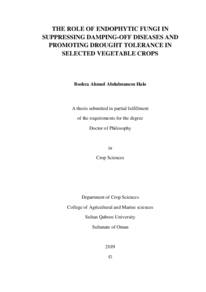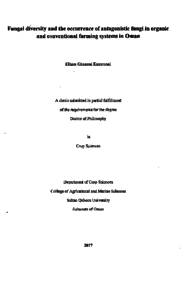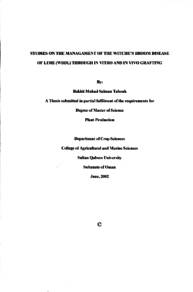وثيقة
.The role of endophytic fungi in suppressing damping-off diseases and promoting drought tolerance in selected vegetable crops
الناشر
Sultan Qaboos University
ميلادي
2019
اللغة
الأنجليزية
الموضوع
الملخص الإنجليزي
Pythium-induced diseases and drought are two challenges limiting vegetable production in Oman. In this thesis entitled: "The role of endophytic fungi in suppressing damping-off diseases and promoting drought tolerance in selected
vegetable crops" endophytic fungi were isolated from native desert plants, which naturally live under extreme stressful conditions such as drought and heat, and were used to mitigate the biotic and abiotic factors in crop plants, particularly tomatoes.
The three main objectives of this study were to investigate: (1) fungal diversity in desert plants in Oman; (2) the ability of the isolated fungi in suppressing Pythium- induced damping-off of vegetable crops; and (3) the ability of fungal isolates in
improving drought tolerance.
The first part of this study focused on isolation and identification of endophytic fungi from native desert plants. The identified endophytes were Aspergillus terreus from Rhazya stricta and Tephrosia apollinea desert plants and Talaromyces variabilis
from R. stricta and Zygophyllum coccineum desert plants. In addition, the study identified two novel fungal species in Oman, Cladosporium omanense sp. nov. and Talaromyces omanensis. C. omanense was obtained from Z. coccineum, and its
identity was confirmed based on morphological characteristics as well as phylogenetic analysis based on the combined internal transcribed spacer (ITS), partial translation elongation factor 1-alpha (TEF) and partial actin (ACT) sequence data. C.
omanense differed from its phylogenetically related species C. endophyticum by its fast growing colonies and in having longer macronematous and micronematous conidiophores, thick-walled conidia with conspicuously protuberant shrivelling
surface ornamentation. The second new species, T. omanensis was isolated from the desert plant R. stricta. The new species forms a distinct sister clade to the section Subinflati in the phylogeny of internal transcribed spacer (ITS), β-tubulin (benA) and
Calmodulin (CaM). This fungus remains distinct and unique from the other species in the section Subinflati in having monoverticillate conidiophores.
The second part of the study investigated the use of the identified endophytes in biological control against Pythium aphanidermatum. Aspergillus terreus (isolates 65P and 9F) inhibited the growth of P. aphanidermatum in culture and caused
abnormal growth and loss of internal content of P. aphanidermatum hyphae. The culture filtrate (CF) of A. terreus resulted in significant rise in cellular leakage of P.
aphanidermatum mycelium and reduced spore production. A. terreus also produced glucanase enzyme and siderophore. This suggests that the cell walls of Pythium, which consist of glucan, are affected by the glucanase enzyme produced by A.
terreus. The siderophore is suggested to be involved in the inhibition of Pythium growth. In bioassay tests, the two isolates increased the survival rate of cucumber seedlings. In addition, they did not have any negative effects on the growth of
cucumber seedlings.
The study also investigated the ability of T. variabilis in interfering with P. aphanidermatum growth and suppressing Pythium-induced damping-off of cucumbers and tomatoes. T. variabilis inhibited the in vitro growth of P.
aphanidermatum and caused abnormalities in P. aphanidermatum hyphae. Extracts from T. variabilis induced cellular leakage and suppressed oospore production of P.
aphanidermatum. Moreover, this study confirmed the efficient role of T. variabilis isolates in suppressing damping-off of cucumbers and tomatoes. Also, T. variabilis produced glucanase, cellulase and siderophores, suggesting the contribution of these metabolites in the inhibition of P. aphandermatum and its induced damping-off.
Cladosporium omanense inhibited growth of P. aphanidermatum and caused abnormalities in its hyphae. In addition, extracts form the fungus caused considerable cellular leakage and inhibited oospore production. In addition, bioassay test showed
that cucumber and radish damping-off diseases were significantly inhibited by C.
omanense, which may be attributed to its ability to produce cellulase, β-1,3- glucanases and siderophores.
The third and final part of the current study investigated the role of an endophytic fungus T. omanensis in promoting drought tolerance of tomatoes. T. omanensis provided multiple advantages to tomato under drought stress that included improving
reproductive characteristics, chlorophyll fluorescence and some anatomical characters such as increased phloem and cortex width and decreased stem hollow resulting from pith autolysis. In addition, T. omanensis significantly enhanced some
other important plant response parameters under drought stress such as increased shoot dry weight, root length, number of flowers and fruit weight. This study found that significantly higher concentration of gibberellic acid in tomato plants treated by
T. omanensis may have enhanced their drought tolerance.
The study showed that fungal isolates obtained from wild desert plants can have several advantages, including their potential use as antagonists against plant pathogens and to mitigate the effects of drought stress on some crop plants.
المجموعة
URL المصدر
الملخص العربي
تعد الأمراض التي يسببها البيثيوم والجفاف من التحديات التي تقلل من إنتاج الخضروات في سلطنة عمان. وقد خلصت الدراسات السابقة إلى أن استعمال المتنابتات الفطرية أو ما يسمى بالنابوتات الفطرية الداخلية (Endophytic fungi) هي من الطرائق الناجعة للتخفيف من هاتين المشكلتين. في هذه الأطروحة المعنونة ب: "دور المتنابتات الفطرية في قمع أمراض سقوط البادرات المفاجئ وتعزيز تحمل الجفاف في محاصيل خضرية مختارة" تم عزل المتنابتات الفطرية من النباتات الصحراوية الواطنة التي تعيش بشكل طبيعي في ظل ظروف شديدة الإجهاد مثل الجفاف والحرارة، وقد تم استعمالها للحد من تأثير العوامل الإجهادية الحيوية واللاحيوية في نباتات المحاصيل، ولاسيما البندورة. لهذه الدراسة ثلاثة أهداف رئيسة وهي (1) دراسة التنوع الفطري في النباتات الصحراوية في سلطنة عمان، (2) استقصاء قدرة الفطريات المعزولة في قمع مرض موت البادرات (سقوط البادرات المفاجئ) ( Damping - off ) في المحاصيل الخضرية والناتج عن الممرض الفطري بيثيوم أفانيدرماتیوم (Pvthiu aphanideviatu)، (3) وكذلك استقصاء قدرة هذه العزلات الفطرية في تحسين تحمل الجفاف.
ركز القسم الأول من الأطروحة على عزل وتعريف المتنابتات الفطرية والمعزولة من النباتات الصحراوية الواطنة، وأظهرت الدراسة التصنيفية أن المتنايتات الفطرية كانت تتبع نوع الرشاشية الأرضية ( Aspergillus ferreus) والتي تم عزلها من نباتي الحرمل (Rhazya stricta) والظفراء الأبولونية ( Tephrosia apollinea) الصحراويين، ونوع التالارومیسیس المتبدل (Talaromyces variabilis) المعزول من نباتي الحرمل والرطريط (Zygophyllum coccineum) الصحراويين، كما تم تعريف نوعين فطريين جديدين في غمان هما الطوقي البوغي العماني (Cladosporium omanense)، والتالار وميسيس العماني (Talaromyces omanensis)، تم عزل المتنايت الجديد الطوقي البوغي العماني من نبات الرطريط في عمان، وقد تم تعريفة اعتمادا على التوصيف الشكلي ومعطيات شجرة تطور السلالات والتي اعتمدت بدورها على بيانات تسلسل المورثات الثلاث المشترك: ( ITS, TEF , ACT )، كما ثبت من خلال الدراسة أن هذا الفطر الجديد مختلف عن الأنواع القريبة منه في شجرة التطور بالنمو السريع المستعمراته، كما أن حوامله الكونيدية الكبيرة والدقيقة كانت أطول من تلك القريبة منها في شجرة التطور، علاوة على ذلك، فقد لوحظ أن كونيديا النوع الجديد ذات جدران سميكة، وتتميز بزخارف سطحية مجعدة وواضحة البروز، أما النوع الآخر التالار وميسيس العماني فقد تم عزله من نبات الحرمل الصحراوي في عمان، وتم توصيفة مظهرية وجزيئية، وقد تبين من خلال الدراسة التصنيفية أن هذا المتنابت الفطري هو نوع فطري دقيق جديد يشكل في شجرة التطور فرعا متمایز وشقيقة لقسم subinflati في جنس التالار وميسيس، كان ذلك مثبتة من خلال بيانات تسلسل المورثات الثلاث: (ITS , benA , CaM)، يتميز وينفرد هذا الفطر عن بقية الأنواع في قسم Subinflati بامتلاكه حوامل كونيدية أحادية المحور.
تم في القسم الثاني من هذه الدراسة استقصاء دور المتنايكات الفطرية المعرفة في المكافحة الحيوية للممرض القطري بيثيوم أفانيدرماتوم، عزلتان من الرشاشية الأرضية ( 65P& 9F ) ثبطتا نمو الممرض الفطري بيثيوم أفاتيدر ماتيوم، وأحدثتا تشوهات في نموه، وفقدانة في المحتوى الداخلي لخيوطه الفطرية، وقد لوحظ أيضا أن رشاحة (السائل الطافي) الرشاشية الأرضية أدت إلى تلف خلوي (تسرب خلوي) ملحوظ في مشيجة الفطر الممرض وإلى نقص حاد في عدد أبواغة المنتجة، إضافة إلى ذلك فإن هذا الفطر المكافح لديه القدرة على إفراز إنزيم الغلوكاناز ومخلبيات الحديد (حاملات الحديد) (Siderophores)، يشير هذا إلى أن الجدر الخلوية للبيثيوم، والمتكونة من الغلوكان، تأثرت بإنزيم الغلوكاناز الذي أنتجته الرشاشية الأرضية، كما تقترح الدراسة مساهمة مخلبيات الحديد المفرزة من قبل الفطر المكافح في تثبيط نمو البيثيوم، أما الاختبارات الحيوية فقد بينت أن كلا العزلتان قد استطاعتا قمع مرض موت بادرات الخيار الناتج عن الممرض الفطري بيثيوم أفانيدر ماتيوم، بالإضافة إلى ذلك، فإنه لم يكن للعزلتين أي آثار سلبية في نمو شتلات الخيار.
كما تحققت الدراسة من قدرة المتنایت الفطري التالاروميسيس المتبدل على معارضة نمو الفطر الممرض بيثيوم أفانيدر ماتيوم وقمع ما يسببه من مرض موت بادرات الخيار والبندورة، أوجدت الدراسة أن الفطر المكافح التالارومیسیس المتبدل يثبط مختبرية نمو الفطر الممرض في الأوساط الصلبة والسائلة، ويحدث تشوهات شكلية في خيوط الفطر الممرض، كما أن رشاحة الفطر المكافح أحدثت تلفة خلوية في مشيجة الفطر الممرض وقمعت إنتاج أبواغه، إضافة إلى ذلك، فقد أثبتت الدراسة كفاءة فطر التالار وميسيس المتبدل في قمع مرض موت بادرات الخيار والبندورة المحدث من قبل الفطر بيثيوم أفانيدر ماتيوم، إن مقدرة التالارو میسیس المتبدل على إنتاج أنزيمي الغلوكاناز والسيللولاز والمركبات مخلبية الحديد تساهم على الأرجح في النتائج سابقة الذكر.
أما المتنایت الفطري الطوقي البوغي العماني فقد ثبط نمو الليثيوم أفانيدر وماتيوم، وأحدث تشوهات شكلية متميزة في خيوطه الفطرية، وكذلك فإن رشاحة هذا الفطر المكافح سيبت تلف خلوية ملحوظة في مشيجة الفطر الممرض، وقمعة شديدة لإنتاج أبواغه، إضافة إلى ذلك، فإن الطوقي البوغي العماني قمع بكفاءة عالية مرض موت البادرات في الخيار والخس والمحدث بوساطة الفطر الممرض بيثيوم أفانیدروماتيوم، إن مقدرة الطوقي البوغي العماني على إنتاج أنزيمي الغلوكاناز والسيللولاز والمركبات مخلبية الحديد يفسر إلى حد ما تلك التأثيرات القامعة للفطر الممرض.
اهتم القسم الثالث والأخير من الأطروحة بدراسة دور المتنابت الفطري التالار وميسيس العماني في تعزيز تحمل الجفاف في نبات البندورة، وقد أظهرت نتائج الدراسة أن هذا المتنايت يزود البندورة بالعديد من المزايا تحت ظروف إجهاد الجفاف، تتضمن هذه المزايا تحسينة ملحوظة للخصائص التكاثرية، واستشعاع الكلوروفيل، وبعض الصفات التشريحية مثل زيادة عرض اللحاء والقشرة وتقليل تجويف الجذع الناتج عن انحلال المخ (اللب)، إضافة إلى ذلك، فقد عزز التالار وميسيس العماني بشكل ملحوظ بعض السمات الهامة الأخرى تحت ضغط إجهاد الجفاف من مثل زيادة الوزن الجاف للفارع الهوائي، وطول الجذر، وعدد الأزهار ووزن الثمار.
بشكل عام، قد أظهرت الدراسة الحالية أن المتنابتات الفطرية التي تم عزلها من نباتات واطنة برية صحراوية يمكن أن يكون لها العديد من المميزات، بما في ذلك استخدامها المحتمل كعوامل مكافحة حيوية ضد مسببات الأمراض النباتية وكذلك للحد من تأثير إجهاد الجفاف في بعض المحاصيل.
ركز القسم الأول من الأطروحة على عزل وتعريف المتنابتات الفطرية والمعزولة من النباتات الصحراوية الواطنة، وأظهرت الدراسة التصنيفية أن المتنايتات الفطرية كانت تتبع نوع الرشاشية الأرضية ( Aspergillus ferreus) والتي تم عزلها من نباتي الحرمل (Rhazya stricta) والظفراء الأبولونية ( Tephrosia apollinea) الصحراويين، ونوع التالارومیسیس المتبدل (Talaromyces variabilis) المعزول من نباتي الحرمل والرطريط (Zygophyllum coccineum) الصحراويين، كما تم تعريف نوعين فطريين جديدين في غمان هما الطوقي البوغي العماني (Cladosporium omanense)، والتالار وميسيس العماني (Talaromyces omanensis)، تم عزل المتنايت الجديد الطوقي البوغي العماني من نبات الرطريط في عمان، وقد تم تعريفة اعتمادا على التوصيف الشكلي ومعطيات شجرة تطور السلالات والتي اعتمدت بدورها على بيانات تسلسل المورثات الثلاث المشترك: ( ITS, TEF , ACT )، كما ثبت من خلال الدراسة أن هذا الفطر الجديد مختلف عن الأنواع القريبة منه في شجرة التطور بالنمو السريع المستعمراته، كما أن حوامله الكونيدية الكبيرة والدقيقة كانت أطول من تلك القريبة منها في شجرة التطور، علاوة على ذلك، فقد لوحظ أن كونيديا النوع الجديد ذات جدران سميكة، وتتميز بزخارف سطحية مجعدة وواضحة البروز، أما النوع الآخر التالار وميسيس العماني فقد تم عزله من نبات الحرمل الصحراوي في عمان، وتم توصيفة مظهرية وجزيئية، وقد تبين من خلال الدراسة التصنيفية أن هذا المتنابت الفطري هو نوع فطري دقيق جديد يشكل في شجرة التطور فرعا متمایز وشقيقة لقسم subinflati في جنس التالار وميسيس، كان ذلك مثبتة من خلال بيانات تسلسل المورثات الثلاث: (ITS , benA , CaM)، يتميز وينفرد هذا الفطر عن بقية الأنواع في قسم Subinflati بامتلاكه حوامل كونيدية أحادية المحور.
تم في القسم الثاني من هذه الدراسة استقصاء دور المتنايكات الفطرية المعرفة في المكافحة الحيوية للممرض القطري بيثيوم أفانيدرماتوم، عزلتان من الرشاشية الأرضية ( 65P& 9F ) ثبطتا نمو الممرض الفطري بيثيوم أفاتيدر ماتيوم، وأحدثتا تشوهات في نموه، وفقدانة في المحتوى الداخلي لخيوطه الفطرية، وقد لوحظ أيضا أن رشاحة (السائل الطافي) الرشاشية الأرضية أدت إلى تلف خلوي (تسرب خلوي) ملحوظ في مشيجة الفطر الممرض وإلى نقص حاد في عدد أبواغة المنتجة، إضافة إلى ذلك فإن هذا الفطر المكافح لديه القدرة على إفراز إنزيم الغلوكاناز ومخلبيات الحديد (حاملات الحديد) (Siderophores)، يشير هذا إلى أن الجدر الخلوية للبيثيوم، والمتكونة من الغلوكان، تأثرت بإنزيم الغلوكاناز الذي أنتجته الرشاشية الأرضية، كما تقترح الدراسة مساهمة مخلبيات الحديد المفرزة من قبل الفطر المكافح في تثبيط نمو البيثيوم، أما الاختبارات الحيوية فقد بينت أن كلا العزلتان قد استطاعتا قمع مرض موت بادرات الخيار الناتج عن الممرض الفطري بيثيوم أفانيدر ماتيوم، بالإضافة إلى ذلك، فإنه لم يكن للعزلتين أي آثار سلبية في نمو شتلات الخيار.
كما تحققت الدراسة من قدرة المتنایت الفطري التالاروميسيس المتبدل على معارضة نمو الفطر الممرض بيثيوم أفانيدر ماتيوم وقمع ما يسببه من مرض موت بادرات الخيار والبندورة، أوجدت الدراسة أن الفطر المكافح التالارومیسیس المتبدل يثبط مختبرية نمو الفطر الممرض في الأوساط الصلبة والسائلة، ويحدث تشوهات شكلية في خيوط الفطر الممرض، كما أن رشاحة الفطر المكافح أحدثت تلفة خلوية في مشيجة الفطر الممرض وقمعت إنتاج أبواغه، إضافة إلى ذلك، فقد أثبتت الدراسة كفاءة فطر التالار وميسيس المتبدل في قمع مرض موت بادرات الخيار والبندورة المحدث من قبل الفطر بيثيوم أفانيدر ماتيوم، إن مقدرة التالارو میسیس المتبدل على إنتاج أنزيمي الغلوكاناز والسيللولاز والمركبات مخلبية الحديد تساهم على الأرجح في النتائج سابقة الذكر.
أما المتنایت الفطري الطوقي البوغي العماني فقد ثبط نمو الليثيوم أفانيدر وماتيوم، وأحدث تشوهات شكلية متميزة في خيوطه الفطرية، وكذلك فإن رشاحة هذا الفطر المكافح سيبت تلف خلوية ملحوظة في مشيجة الفطر الممرض، وقمعة شديدة لإنتاج أبواغه، إضافة إلى ذلك، فإن الطوقي البوغي العماني قمع بكفاءة عالية مرض موت البادرات في الخيار والخس والمحدث بوساطة الفطر الممرض بيثيوم أفانیدروماتيوم، إن مقدرة الطوقي البوغي العماني على إنتاج أنزيمي الغلوكاناز والسيللولاز والمركبات مخلبية الحديد يفسر إلى حد ما تلك التأثيرات القامعة للفطر الممرض.
اهتم القسم الثالث والأخير من الأطروحة بدراسة دور المتنابت الفطري التالار وميسيس العماني في تعزيز تحمل الجفاف في نبات البندورة، وقد أظهرت نتائج الدراسة أن هذا المتنايت يزود البندورة بالعديد من المزايا تحت ظروف إجهاد الجفاف، تتضمن هذه المزايا تحسينة ملحوظة للخصائص التكاثرية، واستشعاع الكلوروفيل، وبعض الصفات التشريحية مثل زيادة عرض اللحاء والقشرة وتقليل تجويف الجذع الناتج عن انحلال المخ (اللب)، إضافة إلى ذلك، فقد عزز التالار وميسيس العماني بشكل ملحوظ بعض السمات الهامة الأخرى تحت ضغط إجهاد الجفاف من مثل زيادة الوزن الجاف للفارع الهوائي، وطول الجذر، وعدد الأزهار ووزن الثمار.
بشكل عام، قد أظهرت الدراسة الحالية أن المتنابتات الفطرية التي تم عزلها من نباتات واطنة برية صحراوية يمكن أن يكون لها العديد من المميزات، بما في ذلك استخدامها المحتمل كعوامل مكافحة حيوية ضد مسببات الأمراض النباتية وكذلك للحد من تأثير إجهاد الجفاف في بعض المحاصيل.
قالب العنصر
الرسائل والأطروحات الجامعية



